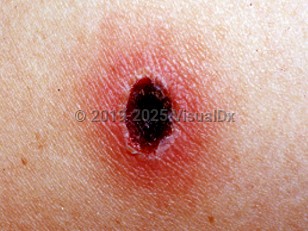Scrub typhus
Alerts and Notices
Important News & Links
Synopsis

Scrub typhus (ST), also known as tsutsugamushi disease or fever, is due to a rickettsial infection by the obligate intracellular bacterium Orientia tsutsugamushi. It is the most common rickettsial infection worldwide and is endemic to Asia, Russian Far East, Northern Australia, and the islands of the Indian and Pacific Oceans. It is contracted from the bite of infected trombiculid mites (natural hosts) when the larval stage mite (chigger) inoculates humans (accidental hosts).
After inoculation from the mite, an incubation period of 10-12 days (range 6-21 days) is followed by the development of a small papule at the bite site that then rapidly forms a black eschar. The patient usually presents with fever, cough, headache, chills, and myalgias. Regional lymphadenopathy may accompany the initial lesion. The location of the bite and subsequent eschar may be on any area of the body but tends to be in skin folds of the axillae and groin area in men and the chest, neck, and abdomen in women.
A week following the onset of fever, a generalized rash consisting of erythematous macules and papules may develop on the trunk and spread to the limbs. This diffuse rash can persist for up to 10 days or fade rapidly.
More severe and prolonged cases exhibit multiorgan failure including pneumonitis with possible acute respiratory distress syndrome (ARDS), hepatitis, acute renal failure, meningoencephalitis, cranial neuropathies, myocarditis, miscarriage, and shock. Infection does not produce long-lived immunity and reinfection is common. Reported fatality rates in untreated cases are as high as 70%.
Individuals who come in contact with low-lying vegetation are at increased risk of infection. Previously, ST has been almost nonexistent in urban areas, but recent trends have noted a change driven by travel, urbanization, global warming, and antibiotic resistance. While some cases of vertical transmission in pregnancy have been reported, there is no horizontal human-to-human transmission.
There is no vaccine for ST.
After inoculation from the mite, an incubation period of 10-12 days (range 6-21 days) is followed by the development of a small papule at the bite site that then rapidly forms a black eschar. The patient usually presents with fever, cough, headache, chills, and myalgias. Regional lymphadenopathy may accompany the initial lesion. The location of the bite and subsequent eschar may be on any area of the body but tends to be in skin folds of the axillae and groin area in men and the chest, neck, and abdomen in women.
A week following the onset of fever, a generalized rash consisting of erythematous macules and papules may develop on the trunk and spread to the limbs. This diffuse rash can persist for up to 10 days or fade rapidly.
More severe and prolonged cases exhibit multiorgan failure including pneumonitis with possible acute respiratory distress syndrome (ARDS), hepatitis, acute renal failure, meningoencephalitis, cranial neuropathies, myocarditis, miscarriage, and shock. Infection does not produce long-lived immunity and reinfection is common. Reported fatality rates in untreated cases are as high as 70%.
Individuals who come in contact with low-lying vegetation are at increased risk of infection. Previously, ST has been almost nonexistent in urban areas, but recent trends have noted a change driven by travel, urbanization, global warming, and antibiotic resistance. While some cases of vertical transmission in pregnancy have been reported, there is no horizontal human-to-human transmission.
There is no vaccine for ST.
Codes
ICD10CM:
A75.3 – Typhus fever due to Rickettsia tsutsugamushi
SNOMEDCT:
271425001 – Scrub typhus
A75.3 – Typhus fever due to Rickettsia tsutsugamushi
SNOMEDCT:
271425001 – Scrub typhus
Look For
Subscription Required
Diagnostic Pearls
Subscription Required
Differential Diagnosis & Pitfalls

To perform a comparison, select diagnoses from the classic differential
Subscription Required
Best Tests
Subscription Required
Management Pearls
Subscription Required
Therapy
Subscription Required
References
Subscription Required
Last Reviewed:12/01/2021
Last Updated:03/30/2025
Last Updated:03/30/2025
Scrub typhus

